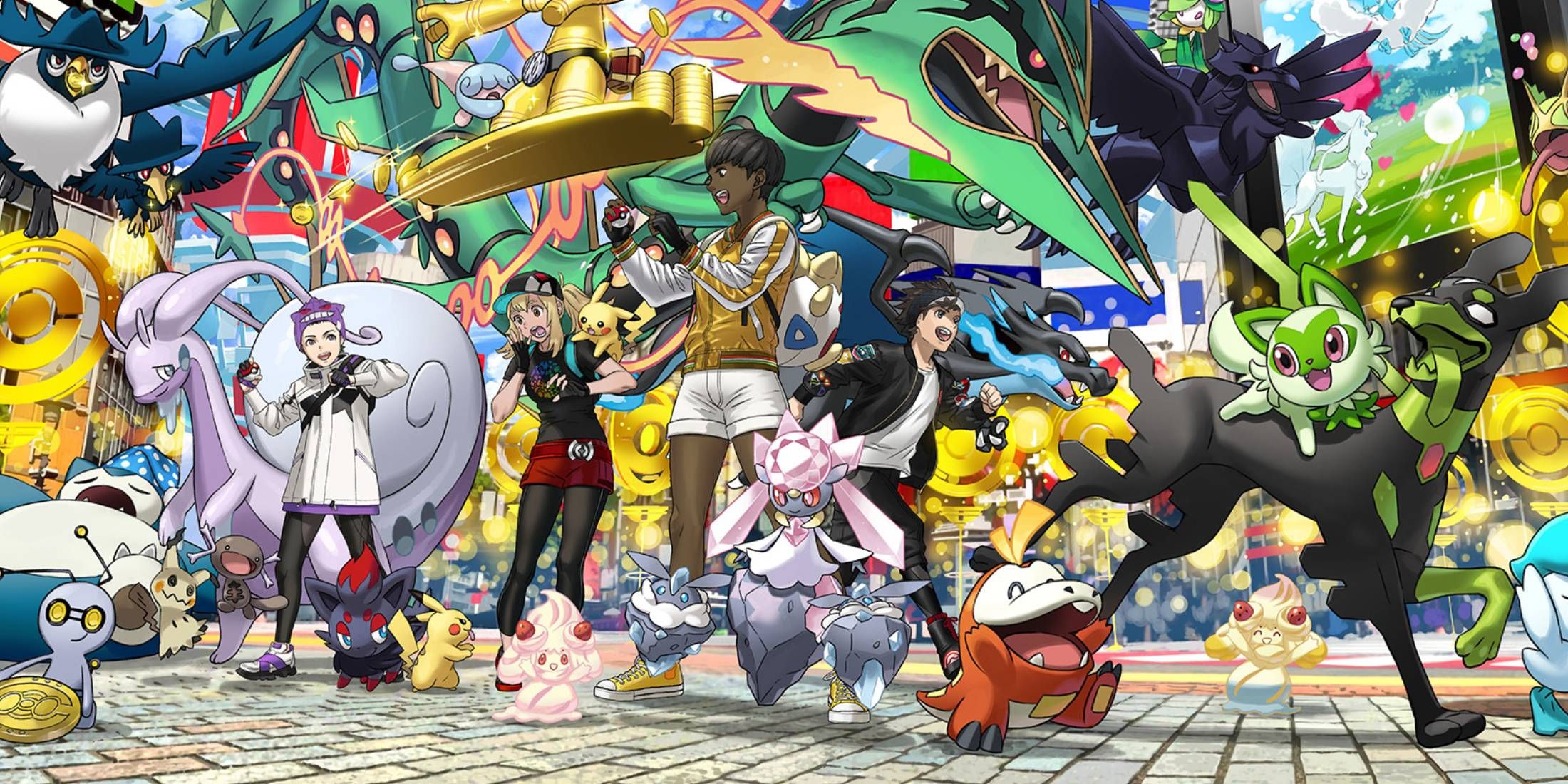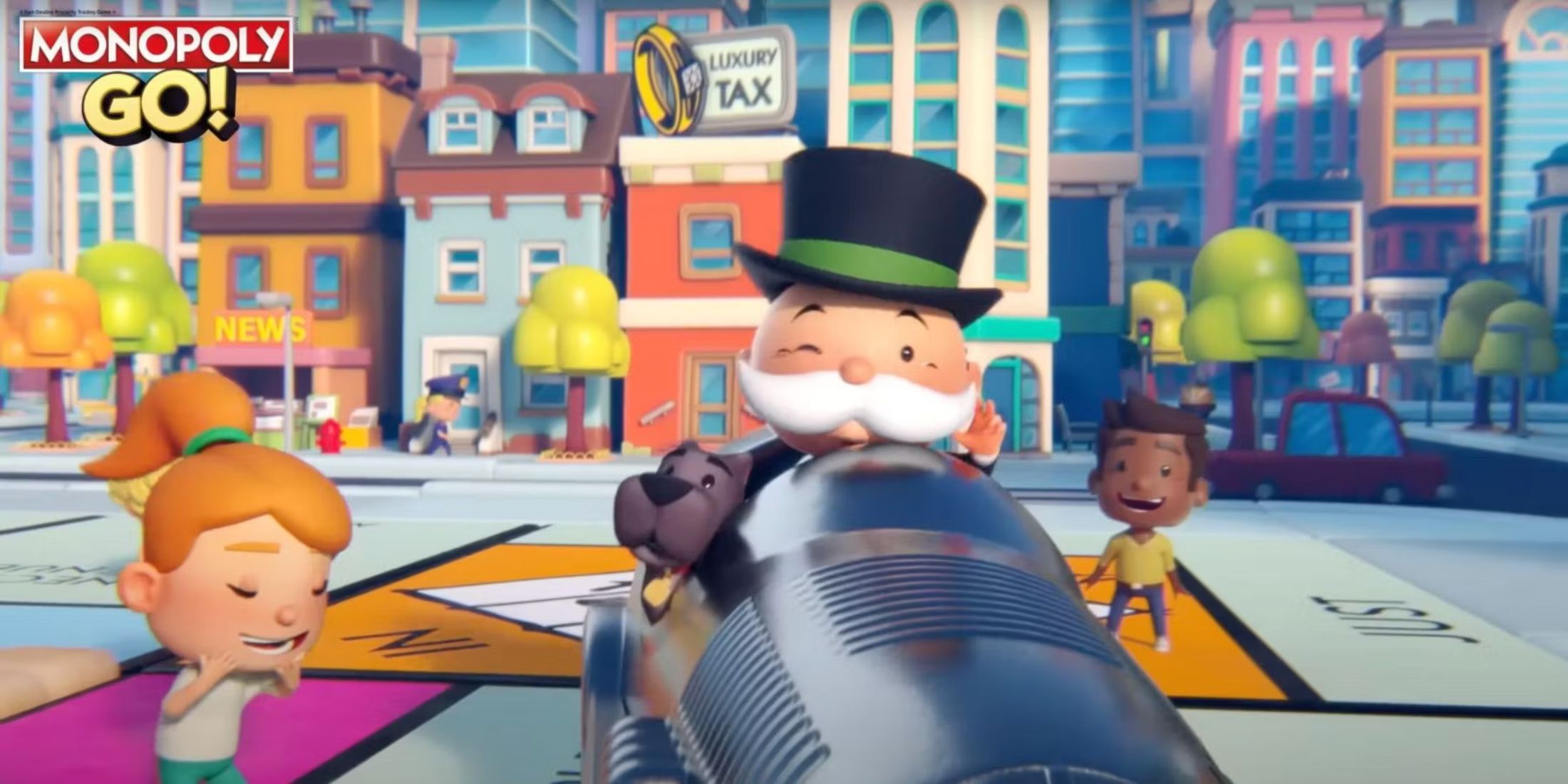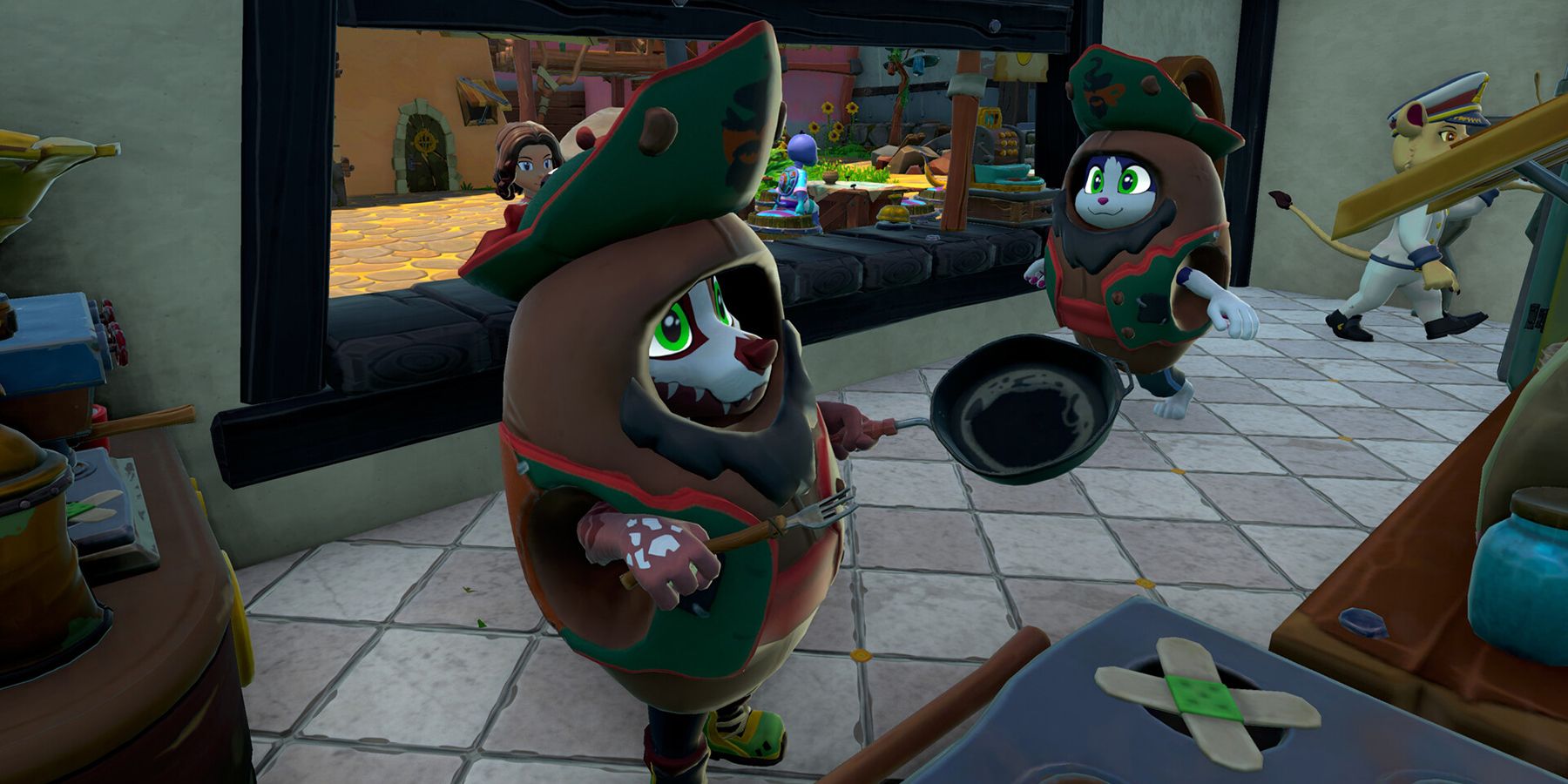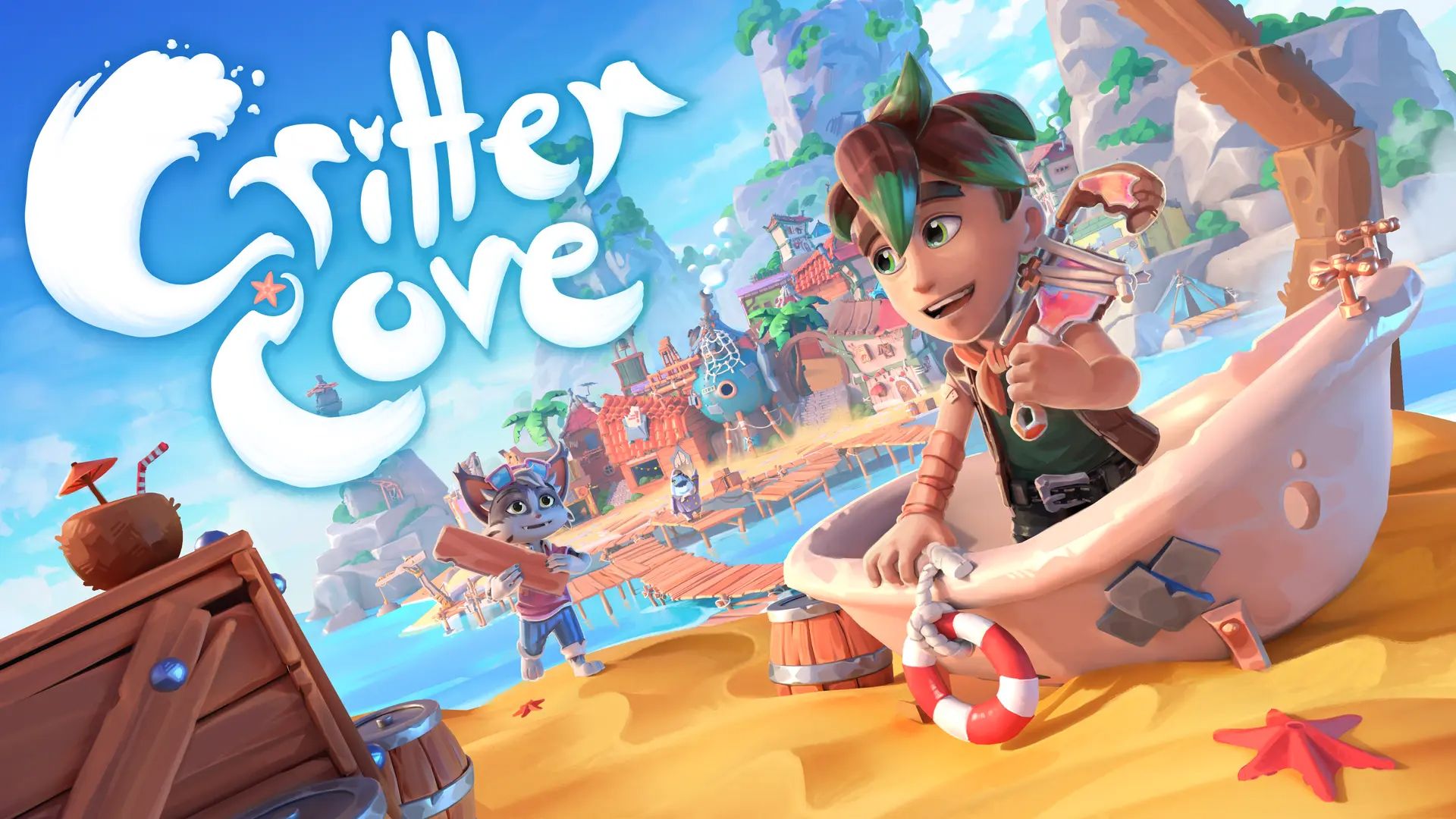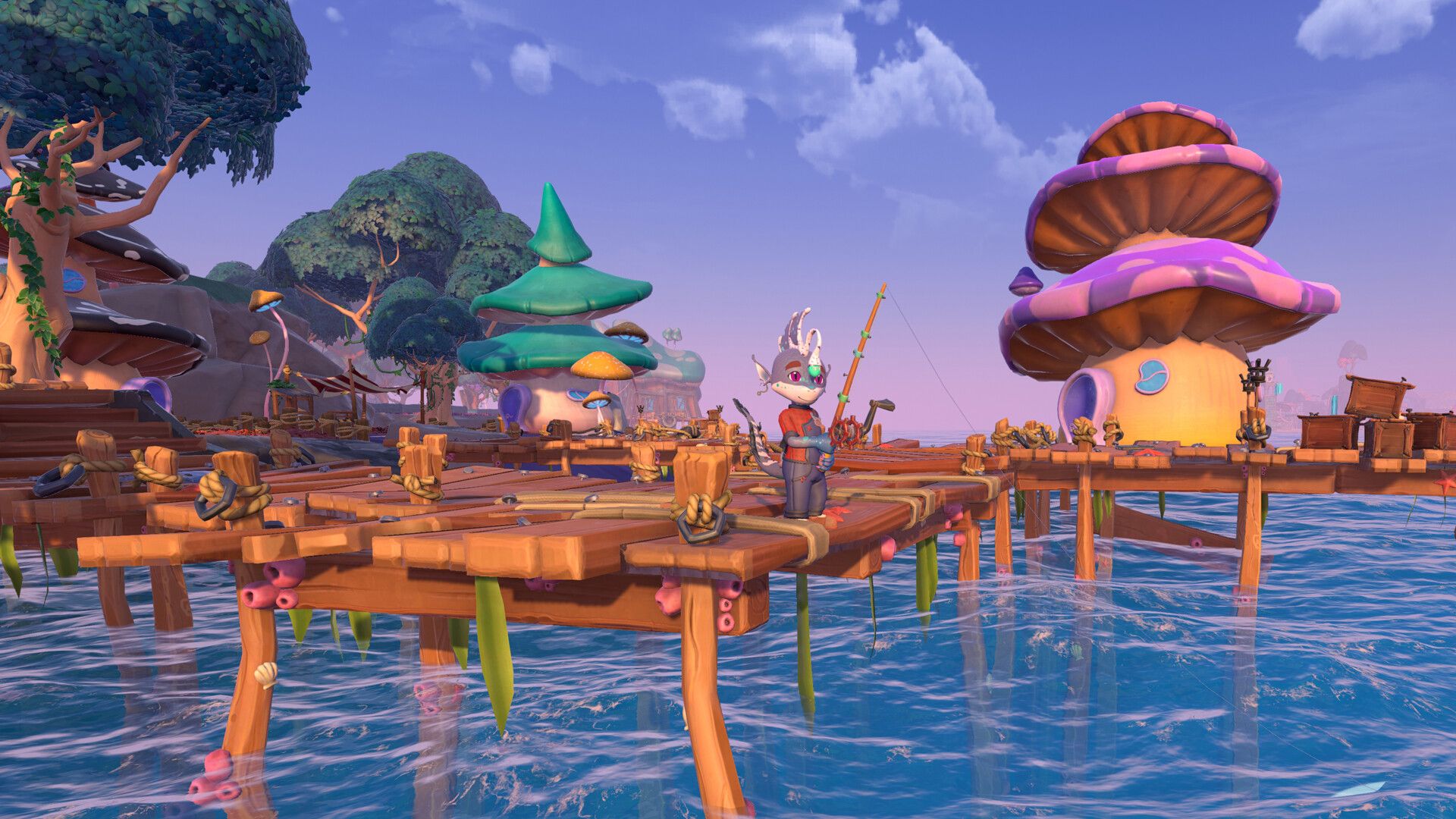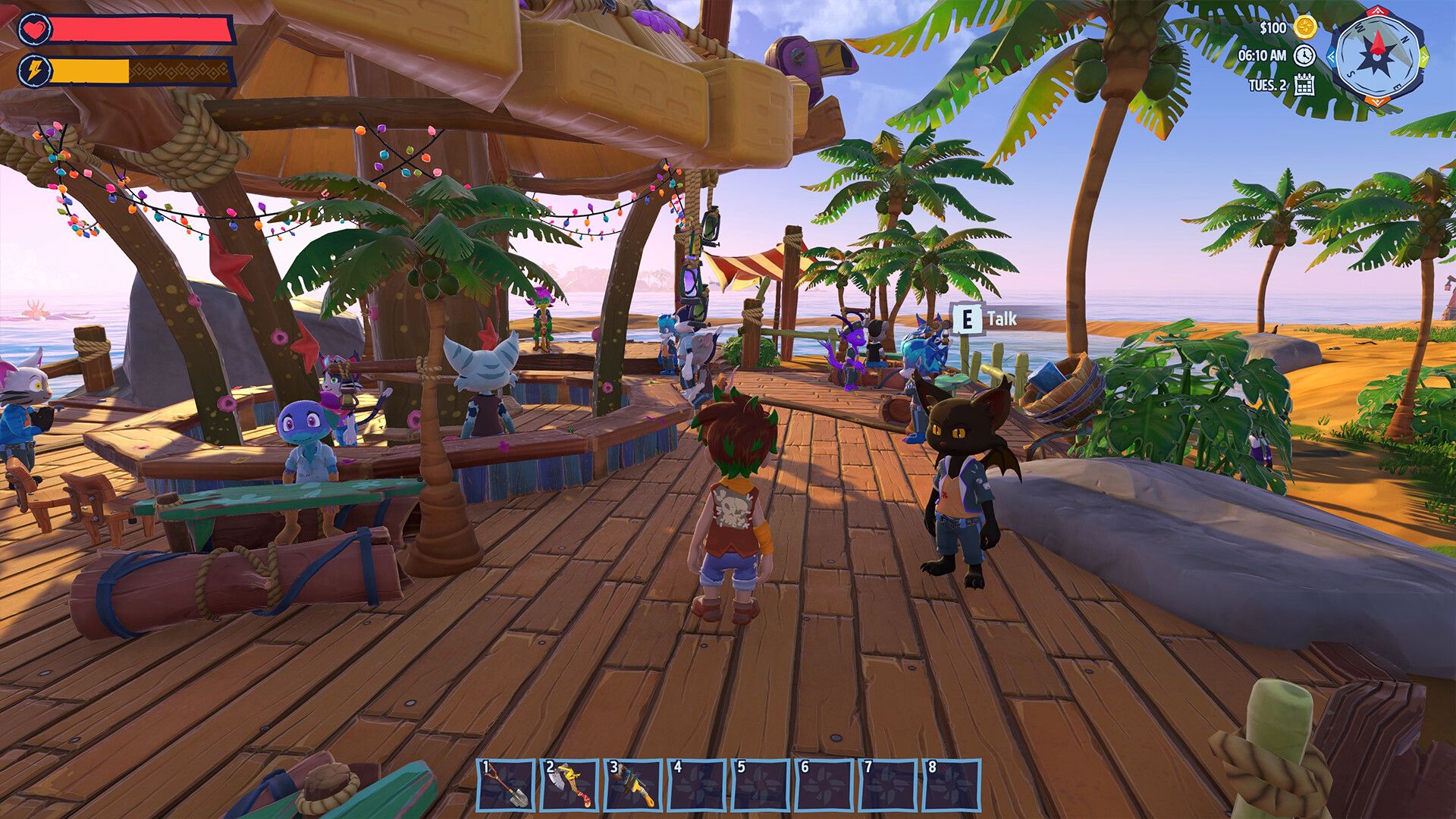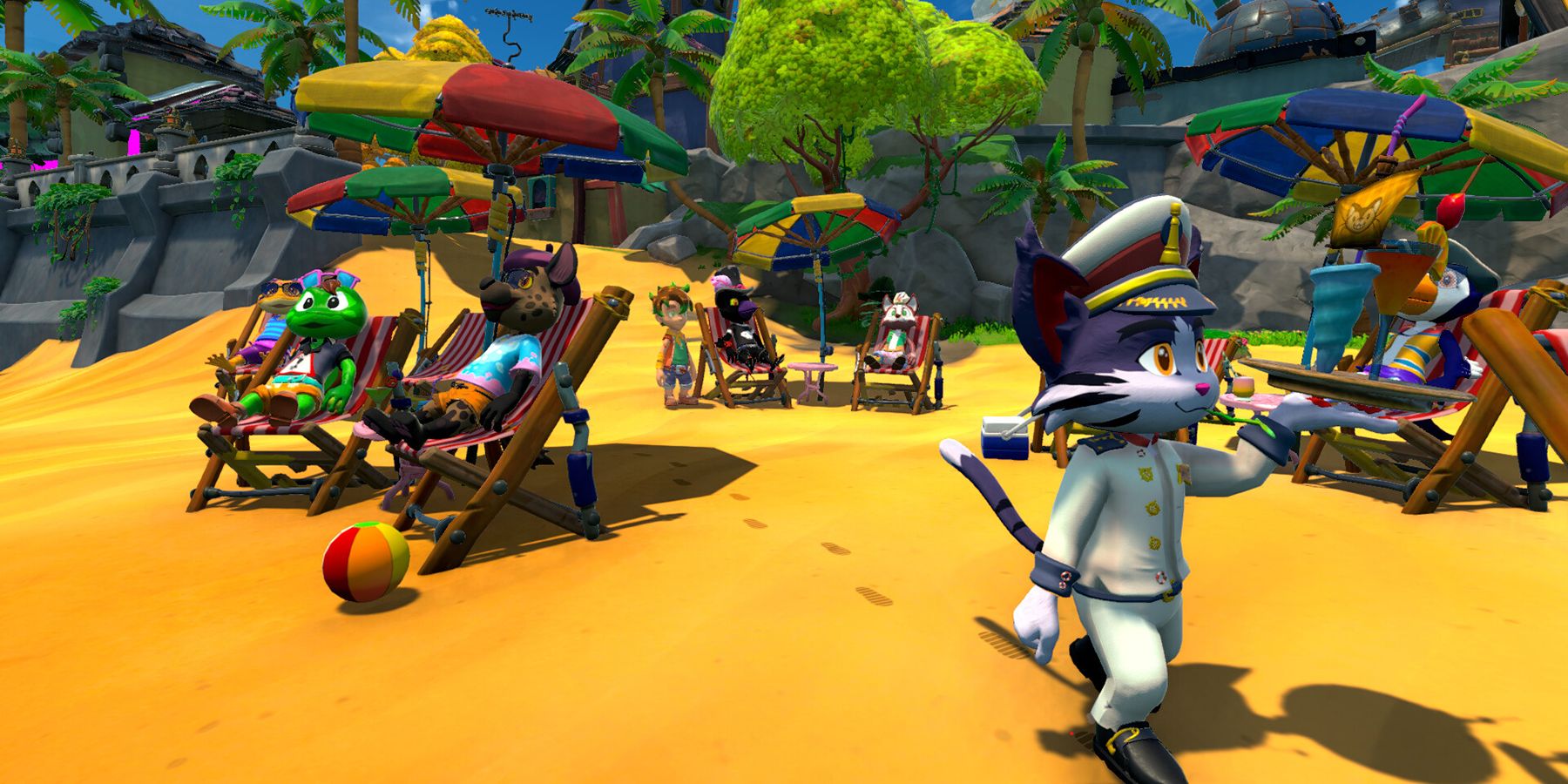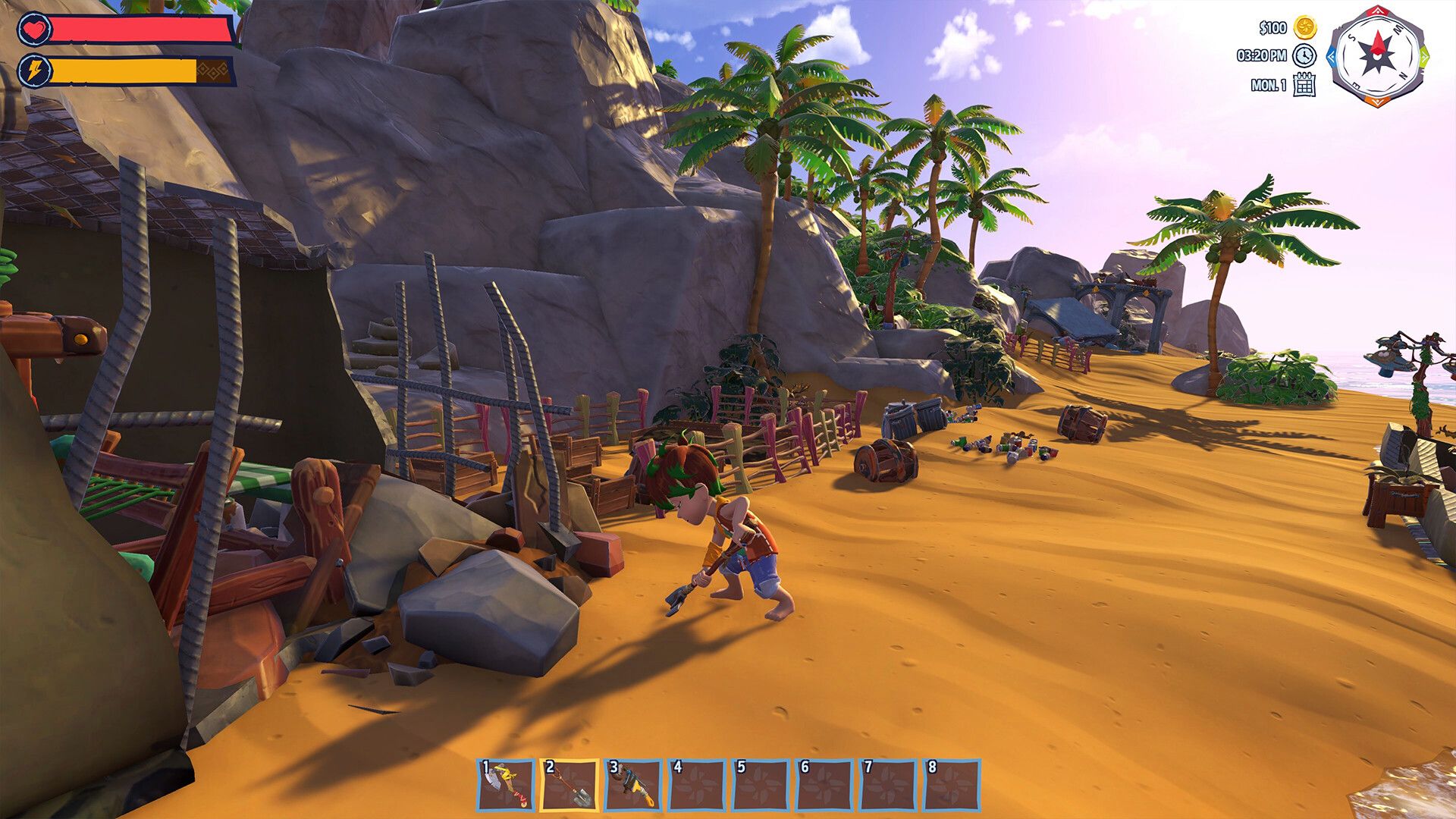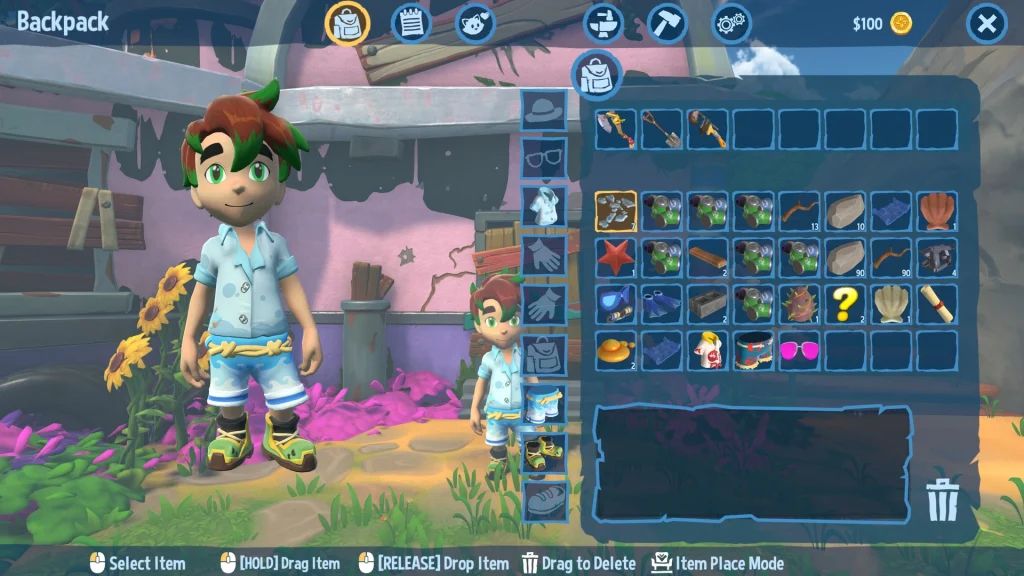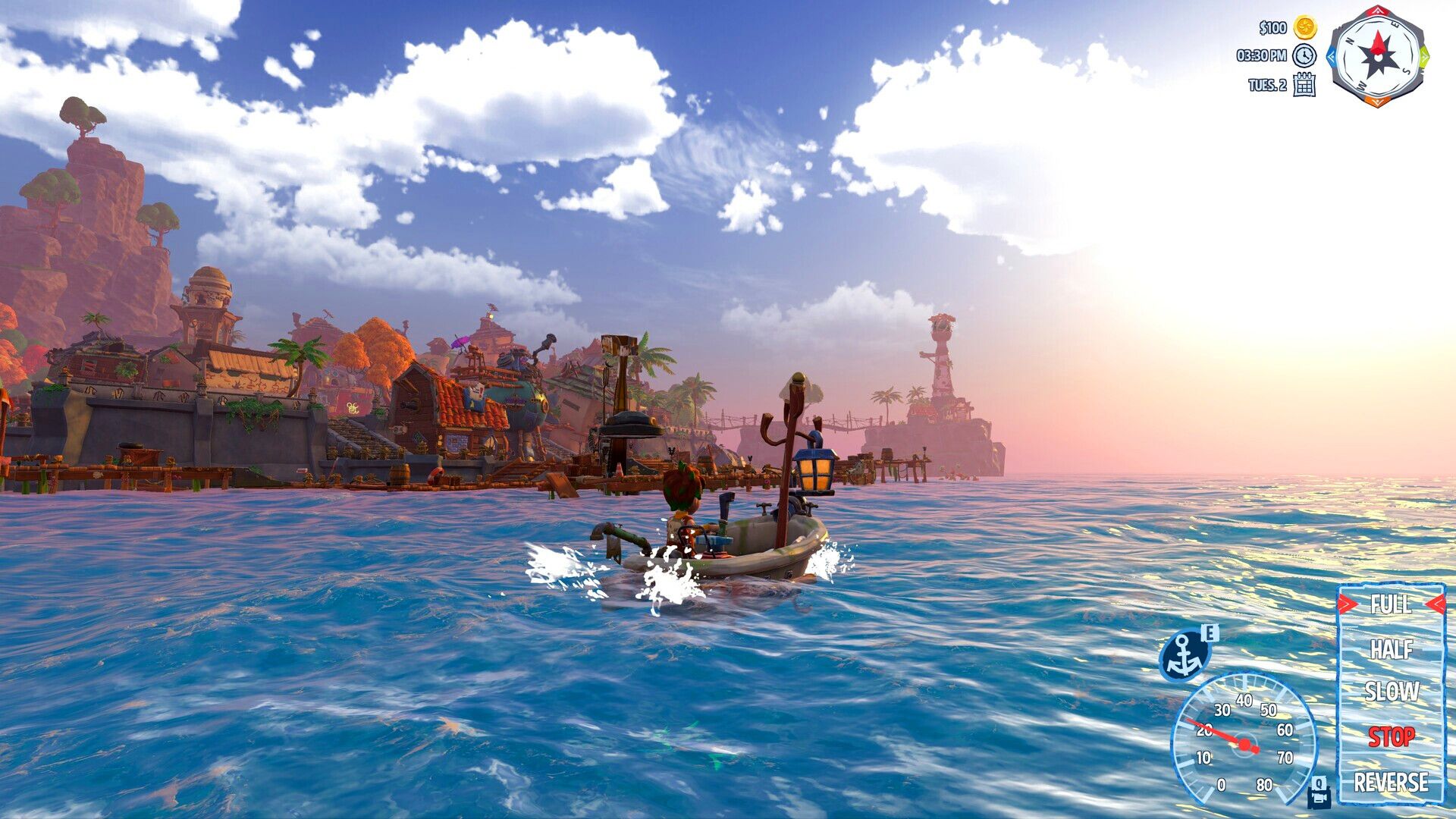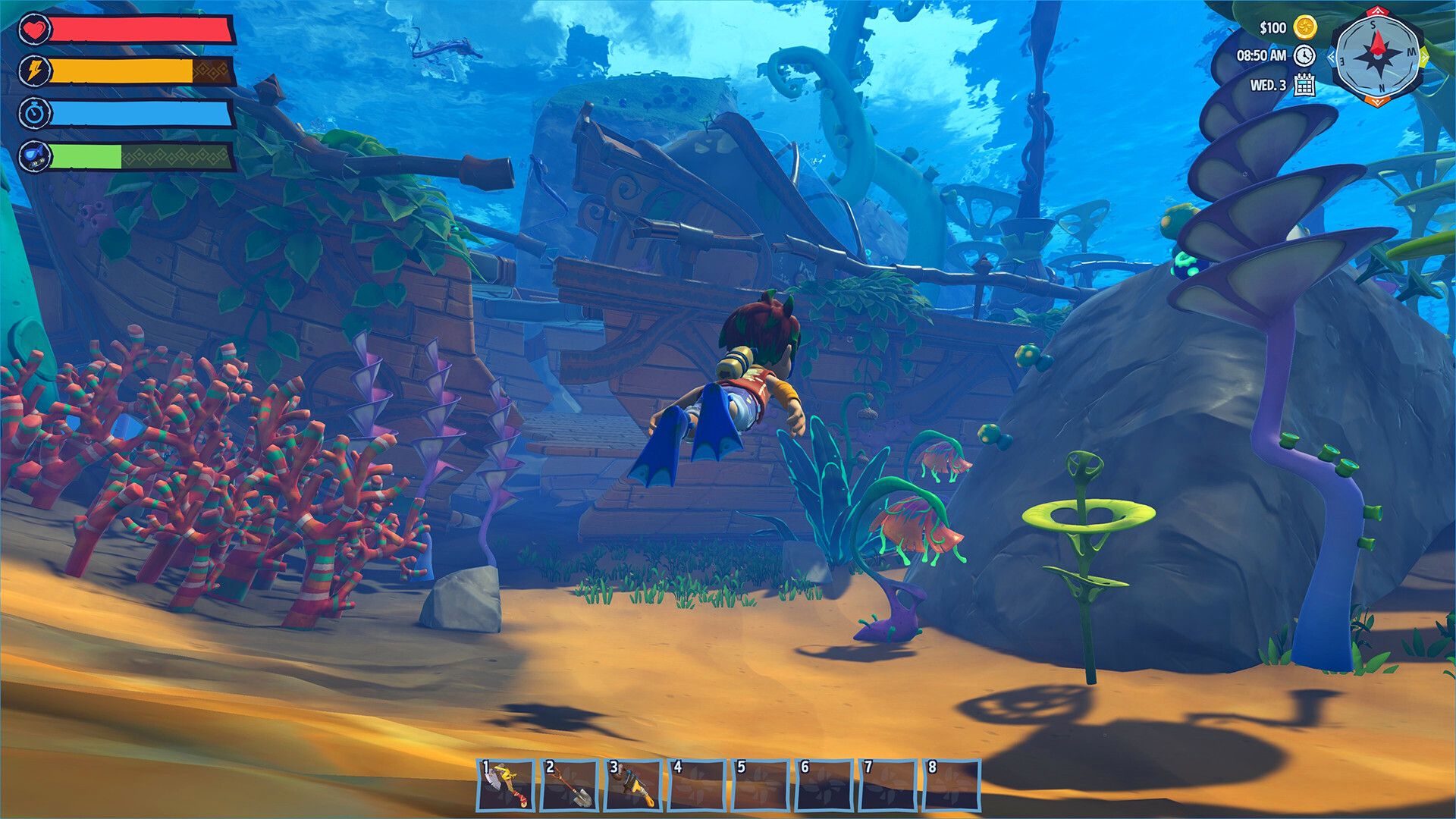Cozy games are all the rage in the hectic modern gaming landscape and take forms ranging from life sims and city builders to exploration games. An indie title entering Early Access in mid-2024, Critter Cove, aims to do all of that and more.
Critter Cove is sprawling, especially for an indie project. It includes deep gameplay systems from a robust character creator to a core loop focused on bringing tourism to the titular town and regularly pushes players to take to the sea and explore the remains of an old, forgotten world both above and below the waves. That’s posed a unique challenge to the team developing the game: it’s hard to describe. To put the ambitious title into words, Game ZXC spoke with developers Eli and Jason Holding as well as Christine Chugon, the three-person team that developed Critter Cove from its beginnings as a very different game to one of the most ambitious cozy titles out there. The following interview has been edited for clarity and brevity.
Q: Can you introduce yourselves?
Jason: Sure thing, I'll start it out. I'm Jason Holding. I am the lead programmer on the project. I've been doing software development for 30-plus years and just got into game programming about 10 years ago.
Eli: Hello. I'm Eli Holding, Jason's younger brother. I'm the lead designer on the project. I've been in games since 2000 and worked on titles like Star Wars Galaxies, Warhammer titles, and several phone titles. I have been in the industry for quite some time.
Chugon: I'm Christine Chugon. I'm the art director. I've also been in the industry for a long time. I think I started in 2003 on Star Wars Galaxies.
Q: What inspired Critter Cove?
Eli: The game came about because we had been looking for a project to work on together: my brother, me, and Christine. She and I have worked together for a long time. We were like, “Hey, look at this, we have an entire team of people who can build a game together," and we actually started with several phone titles. Just some simple mobile puzzle game-type things. We then decided that, you know, mobile wasn't necessarily our thing. It's not what we like to do, so we were like, “hey, let's start doing some work on a PC title.”
We started with a game called Seeds of Magic, which was a 2D farming sim where you are a wizard and use magic to farm or whatever. We did that for a little bit, but then we kept looking at 3D. We decided to make the jump to 3D, and while we were doing that, Jason was messing with some water physics stuff. It was basically a bunch of different parts that came together. It was some stuff from the old Seed of Magic idea and then some of the water physics and stuff like that. It just kind of turned into the very beginnings of Critter Cove. We want to keep some of those fantasy elements that were in the original title, but we felt we needed a more modern approach.
We went with a kind of dystopian idea where it turned into this sort of quirky, post-apocalypse world filled with different weird characters and stuff. It was kind of this natural evolution of several games that we kind of started working on, and then they all came together to become what Critter Cove is.
Jason: It was interesting. We were obvious fans of games like Animal Crossing. We love Stardew Valley. You know, we love cozy games. The interesting thing is, we started this going on almost five years ago, six years ago–at least with Seeds of Magic and the whole evolution of it–so we were in the cozy genre long before it became popular. This game has been developing through that process.
It's taking quite a long time because if you've looked at the game, it's quite large in scope for an indie team, you know, a team of three people to start with. It's grown since then, with our publisher and the people we've worked with after that adding a much larger team. It was just a big, big project; we're talking very few games in the cozy arena trying to tackle a full-on open-world sim. The big thing, like Eli was talking about, is that we have access to the ocean, which other similar games only do in a very, very partial way. Our ocean is just as important as the land, and you can get into the ocean. It's got 3D pathfinding physics for the fish, so things you can interact with underneath the water. It's a huge part of the game.
Our map is very, very large. If you've seen any of the playtests that people have done, you can see it's just a big, big world. That's what we wanted to bring to the cozy community, that idea of exploration. Most cozy games have you in a village doing farming. A take that we wanted to go with was we wanted to be able to explore and get out into the world, and then bring those things back into your community. Your farming and all that tie all those pieces and systems together in a fun, interesting way, but that exploration has been the key that everything centers around.
Chugon: Yeah, we're a lot of stuff. What if it was playing Animal Crossing and going, “Oh, my gosh, I love this. But I want to be able to go out and see what's beyond my little town here. See what's out there and find more people.” We've kinda kind of taken that to heart.
Q: What's the history of the town?
Chugon: It's kind of an old civilization that we don't really explain too much. In the game, we'll throw down hints and stuff, but the idea is that Renard has taken it upon himself to try to put Critter Cove on the map. You have your starting island, and everything is just a ramshackle mess. Everything's sort of falling apart. You need to gather the resources and start bringing people in, and that's where we tie in our tourist system as well. Eli and Jason can talk more about that one.
Jason: Initially, the player doesn't know much about what's going on. It's very much like, “Okay, this is what's happening.” As you explore the world, there are going to be hints and things that will start filling in a few of those blanks. As you explore, you'll find old things that you'll bring back to the museum and some of those will have some interesting information about what came before.
But the key focus of the game right now is more around your existence now, after the apocalypse. That was another take we wanted on this. We wanted a post-apocalyptic game but we kind of call it cozy post-apocalyptic or fun post-apocalyptic because it's a post-apocalyptic paradise, after everything's kind of better. But you still find the remnants of the old world.
Eli: The history of the world is going to be a story that's going to be told in multiple parts. The player will find out what happened to the world, but they have to put it together for themselves. You know, it's going to be told in many different little stories, and once you can combine them, you'll get a pretty good clue about what happened.
As far as the history of the town is, it was an old rundown place that Renard, who's the instigator character, decided he wanted to turn into a tourist paradise, a place where people can visit. He looks at it as a business opportunity, so he hires the player to come and help him fix up this town. He’s the player’s driving force to make a thriving community where many different critters can come and live, and he becomes friends with them. But also at the same time, they all have jobs and things like that where outsiders come and visit the town. The more the player puts effort into the town, the more people will come, and the more profit will be made.
Q: Tell us about some of the colorful characters players will meet?
Eli: Our entire world is populated by these critters. There's animal types, there’s robot types, there's fish types, there's these little Cthulhu monsters, and so on. We have a really wide diverse bunch of characters. One of the first people you'll meet is Renard: Renard is a rat who is profit-motivated, he's a little bit shady, he gets himself involved in some business that's probably not on the up and up, and sometimes he needs the player to help him out. But overall, he's not a bad guy. He's got a little shady side to him. He wants to build Critter Cove into a very thriving town for his own profit.
A few of the other characters are going to meet yours. There's the helper robot Copperbottom, and he’s a handy bot from the old days. He's very, very old. He was built by the people who built the old world. He's kind of a confused guy because he doesn't really understand the motivations of biological people, but he's very curious about it, he wants to learn more, and he wants to expand his horizons and get to know what drives people.
You're also going to meet people out in the world, and that's one of the cool things about our game was we really wanted to make exploration super important to it. When you have an open world, you want to have motivation for people to go out and explore different things. One of the big motivations is finding people who you're going to bring back to your town with you. As you explore, you'll find different islands, and you might find people out on these islands that need some help. You'll help them, and if you're successful in helping them, you can offer them, “Hey, do you want to come back and live in the town with us?” Yeah, they'll come join you, and they'll become citizens in your town. They all have different personalities. There are different personalities that you meet. So you'll meet some people that are maybe a little bit grouchy, you'll meet people who are into athletics, you'll meet people who are very perky and up. You can pick the type of personalities that you like, that you want to interact with, and bring them into your town. Then you give them jobs and they grow, and they become better friends with you as you build your relationships and stuff with them.
There are even some strange characters that you're going to meet along the way. There's a giant statue that doesn't make any sense, but you can talk to it. It's kind of deep, and it's got a personality. There's a crab group–an entire village of crab people. They're just little crabs that chat with you. If you eat the right foods, you can start talking to them, and you'll be able to communicate with them. We definitely have a big, wide, diverse, interesting, quirky group of people that you'll be able to meet in Critter Cove.
Jason: You’ve got Wallington, who's an archaeologist who you meet, and he ends up actually running your museum at some point. He sends you on missions to go out into the world and find these old relics of the old world and bring them back because he's very interested in that. We have some other characters that are artistically oriented and do sculpturing and things like that. And one of the interesting things Christine can talk about, more old school Animal Crossing, is that they used to have a little bit more, I guess, what you would call angry characters? Christine, want to talk to that?
Chugon: Yeah, the grumpy characters! And the sassy characters were much, much meaner, which was great. Those are some of the things that we missed a lot.
My very first Animal Crossing game was Wild World on the DS, and I loved it. I had Chow the panda bear, and he was just mean. The more you talk to him, the more you get to know each other, he gets nicer with you, but I mean, not nice...in a nice sense. He's still, you know, “Everybody else is a bunch of chumps, but you're okay.” I love that, that was great. I felt like I was making progress by doing little favors and stuff for him. I really liked this.
The newer Animal Crossings, as I play on more and more, it's like everyone's starting to feel a little samey. Everybody's just really nice and everyone's really happy to be here. Even if they're sad or angry, they're still positive. We want to bring back some of that grit. We definitely do that. Pokee’s our resident bearded dragon and she's very sassy. She's based on a past pet that we had named Nacho, and she was a sassy little lizard. She was awesome.
Jason: My favorite, I think, is Lance, because he's just insane. He's just kind of off, but he's a fun character.
Q: What home and ship customization is in the game?
Chugon: We do have a large boat and that does have different aspects to it. You start off with a little tugboat. That's your little starter boat, that kind of little dinghy that gets you around some of the nearby islands. Then, when you want to start going out further, that's where you'll start needing your larger boat where you can get upgrades to that for your engine or sails. They're still really small. Everything's very, very ramshackle as well on that boat. It's not like a giant awesome boat, but it is a big boat.
There's a steering wheel. There are all kinds of little things that you can upgrade for your steering speed and that kind of stuff, so turning will be able to be upgraded.
Jason: Can you speak to some of the decorations, Christine? I think, for the home, we've got an absolute ton of decorations.
Chugon: Oh, yes, yes. Oh yeah, we have a massive amount of interior decor items from statues to little interactables, gachapon machines and gumball machines, and all sorts of crazy things that you'll be able to have the NPCs able to interact with and play around with, especially when they open up the touristy stuff. That will be the whole thing–they'll actually be able to start interacting with things, and then depending on how things are going and how much they like the item is how well they'll interact with it. They might be able to shoot off some fireworks and have some fun, or they're going to sort of blow themselves up if they don't know what they're doing. But it's all like Looney Tunes, cartoony. It's nothing terrible. It's all for fun.
Jason: One thing we wanted to do is expand that concept of “I've got my house and I can decorate my interior.” We wanted to expand that kind of concept to the whole city. The town itself, you can almost consider as your home and you can decorate it. You'll be able to decorate and place things anywhere. You can put in lampposts, and like Christine says, you can put in interaction objects. We've got toy rides that you would see outside in front of a grocery store or something that kids would put a quarter into and go on, things like that, that you can just place anywhere you want. Characters will interact with it. There are weight sets if that's what they like, if they're athletically oriented. Just all sorts of things, you name it. We have just tons and tons of decor items.
We also have a pretty intricate decoration system. It allows you to have the concept of things like surfaces, so you can place pictures and things on the walls anywhere you want. You can rotate them, orient them, and you can put objects on surfaces. All the things like tables and armoires, whatever has a surface, even a multi-tier surface where you would have with multiple shelves, you can then put any object you want that can go on the ground or wherever can also be placed on those based on its size. We have grid-oriented or non-grid, so you can place a bunch of little objects, books and things, whatever you want, wherever you can fit them. It's a pretty intricate system, and it allows for a lot of decoration flexibility. I think people so far that have played it really, really enjoyed that part of it.
Eli: For ship customization right now, we have the two hull types. We have the small, the smaller tugboat, which you've probably seen in some of the videos. We've also got a larger haul ship that the player will get a little later into the game. For each one of those, you'll be able to upgrade things like the engine, the rudder, and stuff to make it work. There are upgrades to ensure it goes a little faster, turns a little sharper, those kinds of things. I think that will be a feature that will come during Early Access. The ship stuff probably won't be out right when we do the Early Access, but it'll come in one of those systems that will be added in during that period.
As they said, the entire town is pretty much decorated by the player. You can put down purely decorative items, things like planters and flowers to lampposts and things like that. You can also put down interactive items like chairs, weight sets, easels, horse rides, little old rocking horse rides, and stuff like that, where then the NPCs interact with those as you place them down. As you build your town, the NPCs will also start messing with it.
Jason: My favorite one we just recently added is a catapult and you can get in it, and it'll just hurl you wherever it's facing. If you put it on the beach, the characters will get in and just hurl themselves into the ocean. Then, they'll swim back.
Q: How does the tourism mechanic impact gameplay?
Eli: One of the driving forces behind building up your town is to get more people to live there and more people to visit there. As you're working in your town, you're going to have to build up shops and things in the shops or places like a cafe, a tavern, a gym, and so on. There are several shops that you want to build. As you build these out, they are a draw–the more you build up your town, the more people want to visit your town. They'll arrive, and it'll initially only be a handful of people who show up to check out your town. If there are not a lot of things for people to do, your rating won't be very high, and you won’t earn very much money. You use that money to reinvest in your town, and you build new things for them to do. The decoration stuff also has a purpose in this because it gives activities for these tourists to do. The more activities they have to do, the more they like being there, and the more they like being there, the more money you'll make from the town and the higher rating you'll get.
You start with a very basic town, and then you buy the next tier of what we call a tourism rating. You start with a one. Once you think you're ready, you can buy a two, and once you have two, that means even more people come into town. But if you don't have a whole lot of things for them to do when they get there, that's bad. You want to balance between the number of things you have going on in town versus the number of tourists that are willing to come to town. The whole thing is kind of a loop: you have to build your shops, you have to build your decorations, and then the people will come. And the reason why you want more people to come is so you make more money, so you can buy more shops and more decorations, and it just kind of keeps moving in this circular pattern, in a loop.
Jason: Yeah, it's the economic sim part of these games. In Stardew Valley, you make money by selling stuff and growing stuff. It's the same kind of concept. Our tourism is how we make money in the game, and how you show progress or keep track of how well you're doing by how much cash is brought in. But the big part of it is exploration. It is always still key to this. If you just stay around your local town, there's a limit to the decorated items that you can craft and things that you can find.
In our game, one of the key features–and I just love this feature, I think it's really a unique feature–is that to make anything, you have to go around and deconstruct things. Let's say, you have to go find lampposts, and you have to break them down with your wrench. You learn each time you break one. Maybe after 10 of these, you know how to create a lamppost, but you had to go find those broken lampposts in the first place. You had to do that through exploration. As you go further and further out in the world, you find more and more interesting little things like that.
Chugon: To add on to that exploration part, we also have blueprints as well as treasure chests that you can find. You can find a treasure chest and that'll have like a little rocking horse item in it or a blueprint so that you can craft your own. You can craft those and give them to NPCs or place them around town. We also have the pictograph system where you can find hidden around these little blueprint pictographs that you can sit there and learn.
One of the very first ones you learn is for the fabricator, and you have to find it in a little underwater cave system. That's how you learn how to make the new crafting stations, so we’ll have stuff like that as well, where you can learn some of the new tools that you use either through quests or through these pictographs that you have to find in the world. There's lots of really fun exploration on that side.
Q: Why was the option of making both human and animal player characters a priority for you?
Eli: That kind of came about organically. We were originally only going to have human characters be playable, but we wanted to have a bunch of these animal characters that you'll come across. When we were trying to do it with, you know, just the three of us, this would all be on Christine. She could talk a little bit better about how the characters are made, but it was just going to be simply too much work to try to build 20 to 50 individual characters. So, we created a system where we build them, our character creation system, and that's where we can mix and match patterns and heads and tails and make all these weird things in the eye. The entire idea behind that was for speed so that we could just build all the parts that we needed, and then we could make our cast of hundreds of characters really easily.
While we're doing it, we're playing with it, and we're like, “Hey, this is pretty fun. It is silly for us not to give this to the players.” Now, you build your character with as much power as we could. It just became an extension of the idea that players in these games like customization; they're creators and they like being very creative. “Well, we've already got this system in place. Let's give that to the player to allow them to be creative there too.” Since then, we just kept adding more elements to it, adding new head types, and new patterns, and giving people the power to mix and match. It was really cool watching all the different characters that playtesters make. It's super fun. I just love seeing the creativity of everybody's character.
Jason: They play for two hours before starting the game! There are very few games where you'll genuinely see somebody play for hours and hours, and they're just in the character creator. But that's what I've seen over and over and over. Yeah, it's really the idea that its decoration for yourself. It's taking that idea of decoration even further and being able to customize it, and we're going to keep that in the game. There's a salon in the game, so you'll be able to kind of tweak characters and things later in the game as well, kind of bringing back the character creator as an endgame function.
Chugon: I mean, yeah, the character creator is definitely my baby. Definitely my fun little obsession, I love adding to it. Yeah, I was lucky enough that I, from the technical side of it, worked on a game, Star Wars Galaxies, which had customizable characters in it. I was able to kind of see the inner workings of how to build characters, how to make stuff like this work, and then how to build clothing for them, blend shapes, change hairstyles, and add stuff like that.
Q: What are some of the features you plan on bringing after the beginning of Early Access?
Eli: That hasn't been set in stone yet. Like I said, the ship customization and the expanded player housing will probably be features that come in Early Access. There'll be more stuff done with the tourism system, and there'll be more island exploration content added.
We'll probably also expand things that we already have. We currently have a museum system where you go and collect things. Right now, it's set up so that you'll be collecting treasures that you find, so there'll be treasures that you find out in the world. But we're going to want to expand that to also be able to house the fish and some of the farming elements and stuff because we have a wide variety of very strange plant life. We want to expand what the player can collect. That will probably also come in Early Access so that there'll be more things for the player to explore, more things for the player to collect and put in their museum as a showcase of all the stuff you’ve managed to gather while adventuring.
On the other side of that, we're going to be running some playtests here soon. A lot of our roadmap will be driven by what the players are going to do at this point. We've got our plan for the features that we need to get into Early Access, and then we want to kind of take a look at what the players are doing, and figure out where our weak points are. From there, we'll from leave some space in Early Access to add in direct needs that we see from playtests.
It's not set in stone yet. We have a few ideas, but a lot of it is going to be driven by the upcoming playtests which will determine what elements need to be added or expanded on, because there might be some things that players are very interested in that just need more love down the line.
Jason: We have designed a couple of other biomes, which we'd love to get to. Our next major biome that'll be part of Early Access is our mushroom island fantasy. The game won't look just like what you see around the islands. This is our island biome, there's always some weird stuff, especially when it comes to the flora and fauna, but it has that green island feel to it. The next bar is much more fantasy. You get your purples and it's glowing, and it's big, huge mushrooms. It's a totally different environment, and we would want to expand that to the next biomes whatever those biomes might be. We've also designed some other ones that would be something very different and fun, so it's not just more of the same. It's completely new and interesting for the player to encounter. Again, it's always feeding back into that desire to make exploration pay off.
Chugon: I'll be adding to the characters. Through the past playtests, I already added a whole bunch of notes for things to be added based on people's feedback like, “I really want this kind of horn style or this kind of pattern style.” So I have a list of some things and that list will only get a little bit bigger.
Jason: The game is fairly robust as far as the systems are concerned. We have a complete farming system we haven't even shown off too much, but we are bringing that in the next update and it's going to be brought forward in our next playtest. It's something you start doing early on, but it's always with our quirks. We have straightforward farming. You'll have characters in the town that can actually help you do that because we try to involve the NPCs as much as possible. But we also have this underwater farming system where you have these floating containers, and you put things in there that are that you find in the ocean. Ocean plants that you can then grow and farm and you can place those in the ocean, and they'll float wherever you put them, You can start creating like an Ocean Park. We have fishing and all the typical stuff.
Q: Eli and Christine, you both came from MMOs. Was multiplayer considered for this?
Eli: It was, it's been talked about. There are a lot of challenges with multiplayer that we weren't necessarily super comfortable with as far as just being a three-man team. It's been discussed, it's on the list of maybe we will do this and expand the game out eventually. But I think at first, as of right now, we just want to focus on getting that single-player experience rock solid before we try to expand on anything else. We wanted to make it so that a player will come to our world, be able to get lost in it, and get to build these relationships and friends inside the world. After that, we'll see if multiplayer is something that we try to pull off in the future. But as of right now, we're really focused on just getting the single-player experience right.
Q: Is there anything else any of you would like to add?
Jason: One thing that occurred to me through the playtests, and just working with a lot of my friends in the cozy community: it's just kind of getting a feel for where we fit in into this. It's a quirky game, we've gotten some responses where people were like, “I had no idea until I played the game, I did not think this was what this game was,” until they played it. In the cozy community, right now, games tend to have that isometric, top-down feel. There's a certain vibe to them. I think ours drifts from that a little bit. It's almost like, you know, a little bit of My Time at Sandrock? We kind of flow more into that where it's at full 3D immersive feel to the game. That's something that I just love, being able to just really get myself and my character into the world. This creates a different vibe. That's one thing I think that sets us apart. There are a few other ones out there, but it's a bit of its own little genre.
Chugon: Yeah, I mean, we took a lot of inspiration from our previous work on MMOs so we have a lot of that kind of “do all sorts of crazy stuff in a game and just kind of run around and have fun.” We have a lot of that. We have that hurdle of trying to explain what our game is. It's like this interview, there's just an insane amount of stuff that you can do in the game. It's like, what would you like to do?
Jason: Yeah, that's a really good point, Christine. We've seen it where it can be a little overwhelming, especially for first-time players. They come in, and they're just like, “what do I do?” We've had to learn some lessons there. We need to put a few things on rails, and we need to do a better job of making sure our journals are detailed and give more valid instructions. Because, yeah, it can almost be a little overwhelming. That's part of the problem with doing game design: you've done it over and over and over for years, so it's all natural to us. You don't think about what this would be like if I came in on my own? Eli did a very good job going through the playtest, getting that introduction to the game, and getting people comfortable doing things.
Eli: Yeah, you want to do a good onboarding foundation, and then you have to at some point in time let the game breathe and let the players kind of go, “I understand all the basics of everything I'm supposed to do, now I'm just excited to go see what is over there.” Because exploration is such a big and important part of our game, and we really want to encourage the players when they're playing by giving them rewards for doing it. We tried to fill the world with all sorts of things for you to find both underwater and on different islands.
Jason: Yeah, it's made the messaging harder than we originally thought it would be to communicate what the game is and how it is, what it's about? What kind of feel will it be once you start playing it? That's probably been one of our most difficult problems, that clear communication and messaging of what the game is about. We still hear it, we still have people go, “I was hesitant, and I didn't know what it was, but then I played it and now I freaking love it!” That seems to be the general response. They always say the same thing: “This is not what I was expecting, like this is so much.” I don't know, it's different, bigger, and crazier than what they were expecting. Especially the first time they are able to hop into the water, but now they're just swimming around and diving in.
Eli: I think initial reactions looking at videos, screenshots, and stuff maybe make you think the game is a little younger and immature. I like to think it's not. I think it's a little bit more involved, a little bit more grown-up than sometimes it looks.
Jason: It's something you have to play to really get, I think. I really wish we could do a better job of explaining that to people and communicating that, but we're trying our best.
[END]
Critter Cove will enter Steam Early Access Q2 of 2024.

